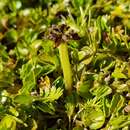zh-TW
在導航的名稱


Caltha novae-zelandiae, commonly known as New Zealand marsh marigold or yellow caltha, is a small (usually 3–5 cm), perennial herbaceous plant belonging to the family Ranunculaceae, that grows in open vegetations in mountainous areas, and is endemic to New Zealand.
The generic name Caltha has been derived from the Greek kalathos 'goblet', refers to the form of the flower. The species epithet novae-zelandiae means of New Zealand.[2]
The New Zealand marsh marigold can be found in the mountains of North, South and Stewart Islands from the main axial ranges of the North Island south. It grows in alpine flushes, seepages, around lakes and slow streaming rivulets. It is also present in moist areas in open grassland, among herbs or between gravel.[2]
Caltha novae-zelandiae is a small (3–5 cm, exceptional up to 18 cm high), hairless, perennial herb. Plants form mats of rosettes. Its white rhizomes are stout and fleshy. The spade-shaped leaves have slender, grooved petioles of up to 10 cm long that form a membranous sheathing base. The leafblade is dark green and sometimes has a central blotch or it has bronze markings, are 8-25 × 4–12 mm with two lobes at its base, with an indent at its tip and entire or slightly scalloped edges. The basal lobes (or appendages) are mostly pressed against the upper surface of the leaf and, almost half as long. The flower grows from an initially short peduncle, that continues to grow till it is finally up to 18 cm long during fruiting. The five to seven pale yellow sepals are 1–3 cm long and 2–3 mm wide, 3-nerved, linear-ovate, widest between the base and half length, and have an acute tip. There are between fifteen and twenty stamens encircling six to twelve ovate carpels each about 4–5 mm long and topped by a stout style of about 2 mm. The fruiting heads are 12–18 mm across. There are usually two to five seeds per follicle, each 1.2-2.0 mm long, glossy red-brown to dark purple brown, ovate to broadly ovate, or elliptic ovate. Flowering occurs between September and December, and ripe fruits can be found from December until March. There are forty eight chromosomes (2n = 48).[2]
C. novae-zelandiae differs from Caltha obtusa by the linear yellow rather than oblong-obovate white sepals, and by the leaf margins which are slightly scalloped to entire rather than scalloped and almost lobed at the base.[2]
Caltha novae-zelandiae, commonly known as New Zealand marsh marigold or yellow caltha, is a small (usually 3–5 cm), perennial herbaceous plant belonging to the family Ranunculaceae, that grows in open vegetations in mountainous areas, and is endemic to New Zealand.
Caltha novae-zelandiae Hook.f., 1852
Дочерние таксоныCaltha novae-zelandiae (лат.) − вид травянистых растений семейства Лютиковые (Ranunculaceae). Была описана в 1852 году английским ботаником Джозефом Долтоном Гукером[2].
Многолетнее травянистое растение 3 − 5 см. Корневища толстые, мясистые, белого цвета. Стебель всегда один, на его верхушке располагается одиночный цветонос. Листья тонкие, образуют розетку. Листовая пластинка темно-зеленая, размерами 8 − 25 × 4 − 12 мм, иногда с центральным пятном бронзового размера. Черешки длиной до 10 см[3].
Чашелистики бледно-желтые, количеством 5 − 7, длиной 1 − 3 см и шириной 2 − 3 мм. Тычинок 15 − 20. Плодолистики овальные, длиной 4 − 5 мм, количеством 6 − 12. Зрелые головки 12 − 18 мм. Цветет с сентября по декабрь, плодоносит с декабря по март. Семена 1,2 − 2 мм длиной, яйцевидной формы, глянцевые, красно-коричневого до темно-фиолетового коричневого цвета[3].
Диплоидный набор хромосом 2n=48[3].
Обитает на альпийских лугах, возле озер и ручьев. Эндемик Новой Зеландии. Встречается на Северном и Южном островах, на острове Стьюарт[3].
Caltha novae-zelandiae (лат.) − вид травянистых растений семейства Лютиковые (Ranunculaceae). Была описана в 1852 году английским ботаником Джозефом Долтоном Гукером.